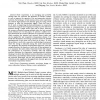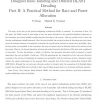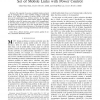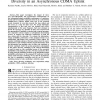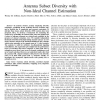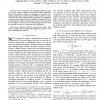TWC
2008
15 years 26 days ago
2008
134
click to vote
TWC
2008
15 years 26 days ago
2008
Node cooperation is an emerging and powerful solution that can overcome the limitation of wireless systems as well as improve the capacity of the next generation wireless networks....
87
Voted
TWC
2008
15 years 26 days ago
2008
The study of the class of new spatial multiplexing architectures (SMAs) is continued. As introduced in Part I of this paper, the SMAs consist of joint design of rate and power all...
68
Voted
TWC
2008
15 years 26 days ago
2008
The capacity of a power controlled wireless network can be changing due to user's mobility, fading or shadowing effects. As a result, the quality of service (QOS) of all users...
TWC
2008
15 years 26 days ago
2008
Abstract-- With the widespread use of mobile devices, the privacy of mobile location information becomes an important issue. In this paper, we present the requirements on protectin...
TWC
2008
15 years 26 days ago
2008
Abstract--This paper investigates the capacity of multipleaccess and broadcast channels with MIMO-MRC systems in spatially correlated environments. We present new capacity approxim...
TWC
2008
15 years 26 days ago
2008
Abstract--This paper investigates the impact of interuser non-orthogonality and asynchronous communication on the information-outage probability performance of multi-user decode-an...
122
Voted
TWC
2008
15 years 26 days ago
2008
In modern wireless systems employing diversity techniques, combining all the available diversity branches may not be feasible due to complexity and resource constraints. To allevia...
118
click to vote
TWC
2008
15 years 26 days ago
2008
Broadcasting allows efficient information sharing and fusion in wireless networks. In this paper, the energy efficiency limits in wireless broadcasting, defined as the minimal achi...
TWC
2008
15 years 26 days ago
2008
A low complexity user scheduling algorithm based on a novel adaptive Markov chain Monte Carlo (AMCMC) method is proposed to achieve the maximal sum capacity in an uplink multiple-i...

